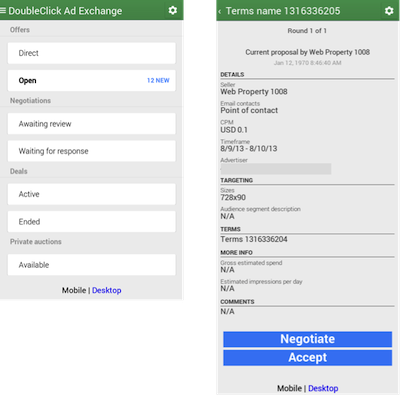Brands and their agencies want to better measure their digital campaigns, but they don’t want one-off science experiments or fuzzy numbers; they want metrics that are as meaningful and actionable as the click has become for performance advertising:
As we invest to improve brand measurement for the entire industry in all these areas, we are keeping a few things in mind. First, measurement should be actionable - real time insights to improve campaigns as they run, not after-the-fact reports that can only improve future ad buys. Second, we know our clients want measurement that is open and transparent so we’re partnering with the industry to create metrics that serve as a true currency between buyers and sellers, and offer flexibility and choice to marketers.
Today at the IAB Leadership Summit, I gave an update on a few of our brand measurement products:
Active View
Last year, comScore estimated that 54% of ads running on the web aren’t seen by the user. Maybe the reader scrolled past your ad; maybe she never got to it.
We’re supporting industry initiatives, like the IAB’s Making Measurement Make Sense (3MS) to establish new standards. And late last year, we made it possible to buy based on viewability on the Google Display Network. This capability is based on our MRC-accredited Active View technology, a transparent and actionable viewability metric that we’re gradually rolling out to both marketers and publishers. It’s early days, but we’ve already seen more than 1,500 brands buying impressions based on viewability, across more than 100,000 sites on our network.
comScore vCE
In TV, marketers use the concept of a Gross Rating Point (GRP), by which they measure the reach and frequency of their campaigns among different demographics. For digital campaigns, there are a number of options for marketers wanting a digital GRP across screens. For example, last year, we started testing comScore vCE (validated Campaign Essentials) and Nielsen OCR (Online Campaign Ratings) for campaigns on YouTube and across our network.
While we’re excited by the efforts in the industry to introduce GRPs to the digital market, we believe we haven’t yet reached the full potential of this metric. And so today, we’re excited to announce that we’re taking another step forward by partnering with comScore to turn vCE into a digitally actionable metric.
By working closely with comScore and the industry, we believe we can make a GRP metric that will be completely actionable: both advertisers and publishers will be able to see if a campaign is reaching the right audience in real time and make adjustments if it isn’t. No more waiting days or weeks for reports, no more wasted media, no more missed opportunities. This objective, third-party vCE metric is being built directly into our DoubleClick ad serving products, where it can serve as a transparent currency for both marketers and publishers to buy, sell and measure ad space across sites, formats and screens.
Brand Lift
At the top of the pyramid, brands want to measure the impact of advertising on core brand metrics like awareness, favorability, purchase consideration and, ultimately, sales. We're developing a suite of Brand Lift products to help here. Last year, we began a small test of surveys to measure the impact of a brand's campaign.
Measuring ad effectiveness by conducting surveys is not new. But generally they’re slow to provide results, and get very low response rates.
In our early tests, we’re seeing 20-30% user response rates (significantly higher than traditional surveys), coming through in near real time. This enables brands to turn the results into immediate action: brands that are using Survey Lift have seen an 82% lift in ad recall, along with a 64% lift in brand awareness. For example MasterCard was able to double brand recall for one of their holiday campaigns based on insights gleaned from surveys. Based on this early promising feedback, we’ll be rolling these surveys out more broadly, for more types of campaigns, in coming months.
Going forward
There’s lots more to come, and we're working on ways to help brands at all stages of the measurement pyramid. More actionable, open and transparent measurement will help bring more great campaigns and brands online, which in turn helps to fund web services and content. We’re looking forward to working with the industry and partners to help make this a reality.


